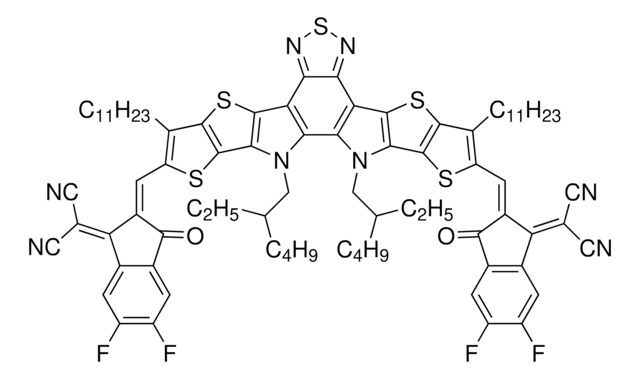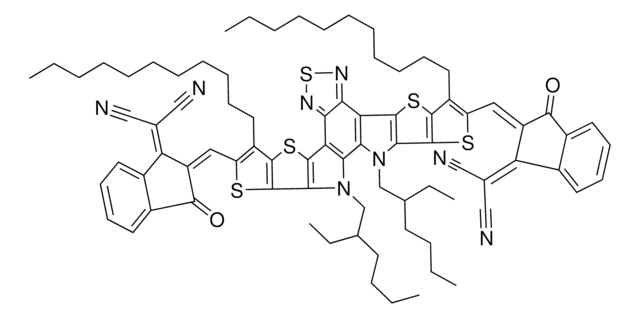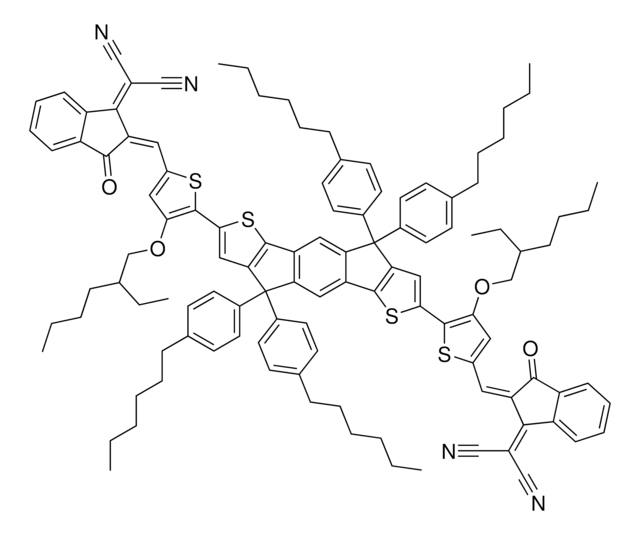933678
Y6(BTPTT-4F)
Sinonimo/i:
Y6, 2,2′-((2Z,2′Z)-((12,13-Bis(2-ethylhexyl)-3,9-diundecyl-12,13-dihydro-[1,2,5]thiadiazolo[3,4-e]thieno-[2",3":4′,5′]thieno[2′,3′:4,5]pyrrolo[3,2-g]thieno-[2′,3′:4,5]thieno[3,2-b]indole-2,10-diyl)bis(methanylylidene))-bis(5,6-difluoro-3-oxo-2,3-dihydro-1H-indene-2,1-diylidene))dimalononitrile
About This Item
Prodotti consigliati
Saggio
≥99% (H-NMR)
Livello qualitativo
Colore
black
Solubilità
chloroform: soluble
λmax
731 nm in chloroform (UV)
Energia dell’orbitale
HOMO - 5.65 eV
LUMO - 4.1 eV
Stringa SMILE
Fc1cc2c(cc1F)C(=C(C#N)C#N)\C(=C\c3[s]c4c([s]c5c4[n](c6c7[n](c8c([s]c%10c8[s]c(c%10CCCCCCCCCCC)\C=C%11/C(=O)c%12c(cc(c(c%12)F)F)C/%11=C(C#N)C#N)c7c9n[s]nc9c65)CC(CCCC)CC)CC(CCCC)CC)c3CCCCCCCCCCC)\C2=O
InChI
1S/C82H86F4N8O2S5/c1-7-13-17-19-21-23-25-27-29-33-51-63(39-57-65(49(41-87)42-88)53-35-59(83)61(85)37-55(53)75(57)95)97-81-73-79(99-77(51)81)67-69-70(92-101-91-69)68-72(71(67)93(73)45-47(11-5)31-15-9-3)94(46-48(12-6)32-16-10-4)74-80(68)100-78-52(34-30-28-2
XJRVXAOYOOOQLU-LAGONYLDSA-N
Cerchi prodotti simili? Visita Guida al confronto tra prodotti
Categorie correlate
Applicazioni
Codice della classe di stoccaggio
11 - Combustible Solids
Classe di pericolosità dell'acqua (WGK)
WGK 3
Punto d’infiammabilità (°F)
Not applicable
Punto d’infiammabilità (°C)
Not applicable
Scegli una delle versioni più recenti:
Certificati d'analisi (COA)
It looks like we've run into a problem, but you can still download Certificates of Analysis from our Documenti section.
Se ti serve aiuto, non esitare a contattarci Servizio Clienti
Possiedi già questo prodotto?
I documenti relativi ai prodotti acquistati recentemente sono disponibili nell’Archivio dei documenti.
Active Filters
Il team dei nostri ricercatori vanta grande esperienza in tutte le aree della ricerca quali Life Science, scienza dei materiali, sintesi chimica, cromatografia, discipline analitiche, ecc..
Contatta l'Assistenza Tecnica.








